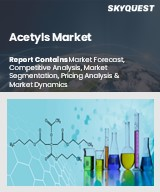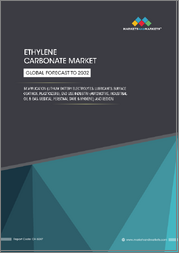
|
시장보고서
상품코드
1681555
세계의 친환경 가소제 시장 : 현황 분석과 예측(2024-2032년)Eco-Friendly Plasticizers Market: Current Analysis and Forecast (2024-2032) |
||||||
친환경 가소제 시장은 예측 기간 동안 CAGR 7.1%로 견조한 성장세를 보일 것으로 예상됩니다. 이는 소형, 고성능, 에너지 효율이 높은 디바이스를 필요로 하는 산업으로 인해 첨단 반도체에 대한 수요가 증가하고 있기 때문입니다. 친환경 가소제 시장의 최근 움직임은 중요한 합병, 인수, 투자, 혁신적 스타트업의 출현을 강조하고 있습니다. 2024년 11월, 호주의 대형 패키징 기업 Amcor는 약 84억 달러 규모의 합병 계약으로 소비자용 플라스틱 용기 및 마개 제조업체인 Berry Global Group을 인수했습니다. Berry Global Group의 인수를 발표했습니다. Amcor는 이번 인수로 세계 최대 규모의 플라스틱 패키징 회사로 거듭나며, 시장 범위와 역량을 확대하게 되었습니다. 이번 합병을 통해 총 매출 240억 달러 규모의 소비자 및 의료용 패키징 분야의 거대 기업이 탄생했습니다.
친환경 가소제 시장은 인도와 중국을 포함한 아시아태평양이 성장을 주도하고 있어 유망한 성장 가능성을 보여주고 있습니다. 이 시장이 급성장하고 있는 것은 산업 발전과 환경 문제, 친환경 소재에 대한 공식적인 승인 등 크게 세 가지 요인에 기인합니다. 소비자들은 환경 친화적 인 포장 선택을 요구하고 규제 기관은 더 엄격한 요구 사항을 시행하고 있기 때문에이 지역의 포장 분야는 본질적인 변화에 직면하고 있습니다. 건설 및 자동차 산업은 다른 분야와 함께 국제적인 지속가능성 요구 사항을 충족해야 하기 때문에 무해한 가소제로 눈을 돌리고 있습니다. 친환경 가소제의 채택은 지속 가능한 미래를 만들기 위해 환경 친화적 인 관행의 구현을 목표로하는 비즈니스 우선 순위에 따라 지속적으로 증가할 것입니다.
제품별로 시장은 바이오 가소제와 프탈레이트 프리 가소제로 분류됩니다. 이 중 프탈레이트 프리 가소제는 높은 CAGR로 성장하고 있습니다. 프탈레이트 프리 가소제의 사용 증가는 프탈레이트에 대한 공중 보건 우려와 발달 문제 및 호르몬 간섭을 포함한 인체 건강 위험을 초래하는 규제와 결합하여 프탈레이트 프리 가소제의 사용이 증가하고 있습니다. 각국 정부 당국은 새로운 안전 정책으로 인해 어린이 장난감과 식품 보존 용품을 포함한 소비재에 함유된 프탈레이트류를 제한하고 있습니다. 산업계가 위험한 물질의 사용을 중단하기를 원하기 때문에 위험한 물질 대신 초지 가소제가 사용되기 시작했습니다. 지속 가능한 제품에 대한 소비자의 관심은 프탈레이트 금지와 함께 제조업체가 시장과 법적 요구 사항에 맞는 안전한 가소제로 전환하도록 유도하고 있습니다.
용도별로 친환경 가소제 시장은 건설, 자동차, 포장, 소비재, 기타로 구분됩니다. 포장 분야는 예측 기간 동안 높은 CAGR을 기록했습니다. 사람들이 친환경 가소제 제품을 선택하는 주된 이유는 환경 친화적이고 화학물질 사용에 대한 새로운 안전 가이드라인을 준수하는 보다 안전한 포장재를 원하기 때문입니다. 환경 문제는 고객과 정부 그룹 모두 지속가능성과 친환경 기능을 통해 지구에 도움이 되는 포장 옵션을 찾기 위해 노력하고 있습니다. 포장 생산자들은 바이오 가소제를 재료로 사용하거나 식품 및 음료 포장재에서 프탈레이트 계열 물질을 제거하고 있습니다. 기업들이 지속가능성을 선택하는 이유는 세계 환경 규제를 충족시키려는 동시에 브랜드 가치를 높이고자 하기 때문입니다.
친환경 가소제 산업 시장 도입에 대한 이해를 돕기 위해 시장은 북미(미국, 캐나다, 기타 북미), 유럽(독일, 영국, 프랑스, 스페인, 이탈리아, 기타 유럽), 아시아태평양(중국, 일본, 인도, 한국, 기타 아시아태평양), 기타 지역(중국, 일본, 인도, 한국, 기타 아시아태평양), 기타 지역의 세계 존재를 기반으로 분석되었습니다. 아시아태평양(APAC) 지역은 세계 친환경 가소제 산업의 주요 지속가능성 중심지 역할을 하고 있습니다. 이는 중국, 인도, 일본, 중국, 인도, 일본이 발전 중인 산업, 소비자 프로토콜, 국가 환경 보호 프레임워크를 활용하여 선도하고 있기 때문입니다. 자동차, 포장, 건설 등 아시아태평양의 대규모 제조업 클러스터는 가장 큰 규모의 사업을 운영하고 있으며, 이들 산업은 모두 현재 친환경 솔루션을 채택하고 있습니다. 이 지역에서는 건강과 환경 문제에 대한 중산층의 인식이 높아지면서 안전하고 무해한 가소제에 대한 수요가 증가하고 있습니다. 친환경 기술 개발에 대한 강력한 투자와 유해 물질에 대한 엄격한 규제가 결합되어 APAC는 친환경 가소제 채택의 중심이 될 것으로 보입니다.
이 시장에서 활동하는 주요 기업으로는 BASF SE, Eastman Chemical Company, Evonik, Lanxess, Lanxess, ExxonMobil Chemical Company, DIC Corporation, Cargill Incorporated, Arkema Group, LG Chem, Valtris Specialty Chemicals 등이 있습니다.
목차
제1장 시장 개요
- 시장의 정의
- 주요 목적
- 이해관계자
- 제한 사항
제2장 분석 방법 또는 전제조건
- 분석 프로세스
- 분석 방법
- 응답자 개요
제3장 주요 요약
- 업계 요약
- 부문별 전망
- 시장 성장 강도
- 지역 전망
제4장 시장 역학
- 성장 촉진요인
- 기회
- 성장 억제요인
- 동향
- PESTEL 분석
- 수요측 분석
- 공급측 분석
- 인수합병(M&A)
- 투자 시나리오
- 업계 인사이트 : 주요 스타트업 기업과 독자적인 전략
제5장 가격 분석
- 가격 분석 : 지역별
- 가격에 영향을 미치는 요인
제6장 세계의 친환경 가소제 시장 매출(2022-2032년)
제7장 시장 분석 : 제품별
- 바이오 가소제
- 프탈레이트에스테르 프리 가소제
제8장 시장 분석 : 용도별
- 건설
- 자동차
- 포장
- 소비재
- 기타
제9장 시장 분석 : 지역별
- 북미
- 미국
- 캐나다
- 기타 북미
- 유럽
- 독일
- 영국
- 스페인
- 프랑스
- 이탈리아
- 기타 유럽
- 아시아태평양
- 중국
- 인도
- 일본
- 한국
- 기타 아시아태평양
- 세계 기타 지역
제10장 밸류체인 분석
- 한계 분석
- 시장 진출기업 리스트
제11장 경쟁 구도
- 경쟁 대시보드
- 기업의 시장 포지셔닝 분석
- Porter의 Five Forces 분석
제12장 기업 개요
- BASF SE
- 기업 개요
- 주요 재무 지표
- SWOT 분석
- 제품 포트폴리오
- 최근 동향
- Eastmen Chemical Company
- Evonik
- Lanxess
- ExxonMobil Chemical Company
- DIC Corporation
- Cargill Incorporated
- Arkema Group
- LG Chem
- Valtris Speciality Chemicals
제13장 두자어와 전제조건
제14장 부록
LSH 25.04.03The eco-friendly plasticizers industry shows rapid expansion because customers focus more on environmental issues while standards for harmful materials become stricter. People use renewable-source-derived eco-friendly plasticizers to achieve enhanced durability and flexibility within polymers because they originate from resources such as vegetable oils and citric acid. These materials provide sustainable solutions for plasticizers since phthalate-based alternatives have raised health-related and environmental issues. The market grows because businesses seek sustainable packaging solutions for food and consumer goods while organizations across automotive and construction require safe, flexible materials. The market transition towards environmentally friendly plasticizers accelerates because customers are becoming more conscious of the negative impacts of traditional plasticizers.
The Eco-Friendly Plasticizers Market is expected to grow at a robust CAGR of 7.1% during the forecast period, owing to the growing demand for advanced semiconductors fueled by industries requiring smaller, high-performance, and energy-efficient devices. Recent activities in the Eco-Friendly Plasticizers market highlight significant mergers, acquisitions, investments, and the emergence of innovative startups. In November 2024, Australian packaging giant Amcor announced its acquisition of Berry Global Group, a leading manufacturer of plastic consumer containers and closures, in a scrip merger deal valued at approximately $8.4 billion. This strategic move positions Amcor as the largest plastic packaging company globally, expanding its market reach and capabilities. It created a consumer and healthcare packaging giant with combined revenues of $24 billion.
The eco-friendly plasticizers market demonstrates promising expansion potential because Asia-Pacific territories, including India and China, are driving growth. The market witnesses rapid expansion because of three primary factors, including industrial developments and environmental concerns, as well as official authorization for green materials. The packaging sector in these areas faces an essential change because consumers want green packaging choices, and regulatory bodies have implemented stricter requirements. The construction and automotive industries, together with other sectors, are turning to non-toxic plasticizers because they must meet international sustainability requirements. The adoption of eco-friendly plasticizers will continue to grow due to business priorities aimed at implementing greener practices that will create a sustainable future.
Based on Product, the market is categorized into Bio-based Plasticizers and Phthalate-Free Plasticizers. Among these, Phthalate-Free Plasticizers is growing with a significant CAGR. The use of phthalate-free plasticizers rises due to public health fears about phthalates combined with regulation which results in human health risks including developmental issues and hormonal interference. Government authorities across nations restrict phthalates in consumer goods including toys for children and food storage items because of new safety policies. Grassland plasticizers are gaining use instead of dangerous materials because industries want to stop using hazardous materials. Consumer concern for sustainable products coupled with phthalate bans encourages makers to switch to safe plasticizers that match market and legal demands.
Based on Application, the Eco-Friendly Plasticizers market is divided into Construction, Automotive, Packaging, Consumer Goods, and Others. The Packaging segment registered a significant CAGR during the forecast period. People choose eco-friendly plasticizer products mainly because they want safer packaging materials that are environmentally friendly and match new safety guidelines for chemical use. Environmental issues push both customers and government groups to find packaging options that help the planet through both sustainability and eco-friendly features. Packaging producers switch to bio-based plasticizers for their materials and remove phthalate-based substances from food and drink packaging. Companies opt for sustainability practices because they desire brand enhancement as they seek to meet worldwide environmental rules.
For a better understanding of the market adoption of the Eco-Friendly Plasticizers industry, the market is analyzed based on its worldwide presence in countries such as North America (U.S.A., Canada, and Rest of North America), Europe (Germany, United Kingdom, France, Spain, Italy, and Rest of Europe), Asia-Pacific (China, Japan, India, South Korea, and Rest of Asia-Pacific), Rest of World. Regions throughout Asia-Pacific (APAC) serve as primary sustainability centers within the global eco-friendly plasticizers industry because China, India, and Japan lead by capitalizing on their developing industries, plus consumer protocols and national environmental protection frameworks. Large manufacturing clusters in APAC, including automotive, packaging, and construction, operate some of the largest operations, but all these industries now adopt environmentally friendly solutions. The increase in awareness among the middle class about health and environmental issues in the region drives up the demand for safe, non-toxic plasticizers. Strong investments in green technological development combined with strict regulations about hazardous substances will allow APAC to remain central in eco-friendly plasticizer adoption.
Some of the major players operating in the market include BASF SE, Eastman Chemical Company, Evonik, Lanxess, ExxonMobil Chemical Company, DIC Corporation, Cargill Incorporated, Arkema Group, LG Chem, and Valtris Specialty Chemicals.
TABLE OF CONTENTS
1.Market Introduction
- 1.1. Market Definitions
- 1.2. Main Objective
- 1.3. Stakeholders
- 1.4. Limitation
2.Research Methodology Or Assumption
- 2.1. Research Process of the Eco-Friendly Plasticizers Market
- 2.2. Research Methodology of the Eco-Friendly Plasticizers Market
- 2.3. Respondent Profile
3.Executive Summary
- 3.1. Industry Synopsis
- 3.2. Segmental Outlook
- 3.2.1. Market Growth Intensity
- 3.3. Regional Outlook
4.Market Dynamics
- 4.1. Drivers
- 4.2. Opportunity
- 4.3. Restraints
- 4.4. Trends
- 4.5. PESTEL Analysis
- 4.6. Demand Side Analysis
- 4.7. Supply Side Analysis
- 4.7.1. Merger & Acquisition
- 4.7.2. Investment Scenario
- 4.7.3. Industry Insights: Leading Startups and Their Unique Strategies
5.Pricing Analysis
- 5.1. Regional Pricing Analysis
- 5.2. Price Influencing Factors
6.Global Eco-Friendly Plasticizers Market Revenue (USD Mn), 2022-2032F
7.Market Insights By Product
- 7.1. Bio-based Plasticizers
- 7.2. Phthalate-Free Plasticizers
8.Market Insights By Application
- 8.1. Construction
- 8.2. Automotive
- 8.3. Packaging
- 8.4. Consumer Goods
- 8.5. Others
9.Market Insights By Region
- 9.1. North America
- 9.1.1. USA
- 9.1.2. Canada
- 9.1.3. Rest of NA
- 9.2. Europe
- 9.2.1. Germany
- 9.2.2. United Kingdom
- 9.2.3. Spain
- 9.2.4. France
- 9.2.5. Italy
- 9.2.6. Rest of Europe
- 9.3. Asia Pacific
- 9.3.1. China
- 9.3.2. India
- 9.3.3. Japan
- 9.3.4. South Korea
- 9.3.5. Rest of APAC
- 9.4. Rest of World
10.Value Chain Analysis
- 10.1. Marginal Analysis
- 10.2. List of Market Participants
11.Competitive Landscape
- 11.1. Competition Dashboard
- 11.2. Competitor Market Positioning Analysis
- 11.3. Porter Five Forces Analysis
12.Company Profiled
- 12.1. BASF SE
- 12.1.1. Company Overview
- 12.1.2. Key Financials
- 12.1.3. SWOT Analysis
- 12.1.4. Product Portfolio
- 12.1.5. Recent Developments
- 12.2. Eastmen Chemical Company
- 12.3. Evonik
- 12.4. Lanxess
- 12.5. ExxonMobil Chemical Company
- 12.6. DIC Corporation
- 12.7. Cargill Incorporated
- 12.8. Arkema Group
- 12.9. LG Chem
- 12.10. Valtris Speciality Chemicals



















